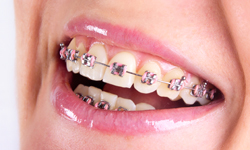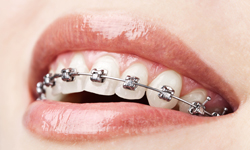Types of Braces
There used to be just one type of braces available, but that’s no longer the case. When you decide to start orthodontic treatment for you or your child, you have options to choose from. Each style has its advantages and disadvantages. Your orthodontist will help evaluate your situation and choose the type of braces that best suits you.
Traditional Metal Braces

Metal braces are what most people think of when they hear “braces”—stainless steel brackets and wires that attach to your teeth with rubber bands. These rubber bands are available in a variety of colors, and many patients enjoy customizing their braces. Modern metal braces are smaller and less noticeable than they were in the past. They are still the most common type of braces.
Self-Ligating Braces

This type of braces is similar to traditional metal braces. The main difference between the two styles is that self-litigating braces do not require the use of rubber bands. Instead, they use a special type of clip to hold the wire onto the bracket. The result? Less friction on the teeth and fewer visits to your orthodontist. The brackets for self-litigating braces can be made of metal, ceramic, or clear material.
Clear (Ceramic) Braces

Some brackets are made of clear ceramic materials, making them more difficult to see than metal braces. While they offer a subtler look, they also come with a few disadvantages. They are larger and more brittle, so they require more careful oral hygiene. Typically, they are more used on upper front teeth than in other areas of the mouth.
Clear Aligners

These are invisible trays that you wear over your teeth that gradually move them into desired alignment. Patients remove the trays before eating or drinking, so there is no need to restrict your diet while using clear aligners. This also makes brushing and flossing hassle-free. Since these are made of smooth plastic, patients don’t run into problems like wires poking their gums and cheeks.
Not sure what option is right for you or your child? Schedule a complimentary consultation at our office to find out more about treatment options.




 Website Powered by Sesame 24-7™
Website Powered by Sesame 24-7™